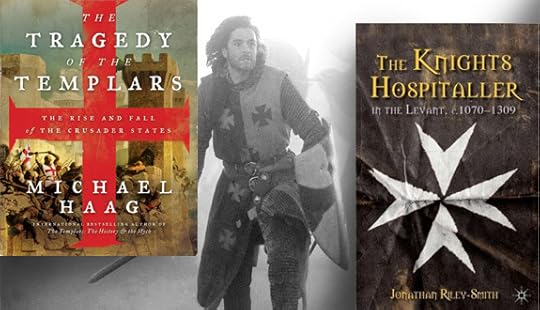Shedding Light on Misunderstood Knights

Shedding Light on
Misunderstood Knights |
Vincent Ryan | Catholic World Report
Two new books about
the Templars and the Hospitallers separate historical fact from
popular fiction
Michael Haag, The
Tragedy of the Templars: The Rise and Fall of the Crusader States
(Harper: New York, 2013) 448 pp, paperback, $16.99
Jonathan Riley-Smith,
The Knights Hospitaller in the Levant, c. 1070-1309 (Palgrave
Macmillan: New York, 2012) 352 pp, hardcover, $105.00
One of the most
commonly perpetuated myths about the First Crusade is that
participation in the campaign was primarily driven by economic
motivations, particularly by younger sons who had minimal inheritance
prospects and thus regarded the crusade as a promising land-grab.
Specialists in this field have eviscerated this dubious premise. For
instance, computer-based prosopographical studies of the first
crusaders have shown that the expedition was actually largely
comprised of the oldest sons, who had access to the family’s assets
which were essential to financing their participation in the
crusade.
The behavior of the
first crusaders further illustrates how deeply flawed this notion
that participants were chiefly interested in acquiring lands. After
capturing Jerusalem in the summer of 1099, most of the crusaders
venerated the holy sepulcher and returned to Europe. Manpower
shortages were one of the most pressing problems for the Latin
Christians who remained in the region. The emergence and growth of
the Templars and Hospitallers was one response to this mounting
crisis. Two recent books on these respective military orders
highlight the central role that each played in the defense of the
crusader states in the twelfth and thirteenth centuries.
The Origins of the
Templars
The Tragedy of the
Templars: The Rise and Fall of the Crusader States by Michael
Haag at first glance might seem like another entry in the publishing
subgenre of Templar-related nonsense.
The somewhat sensationalist title is likely a reflection of
marketing concerns, as the book itself is a fairly sober and
thought-provoking study. This is the second tome that Haag has
written on the order, and his ease and confidence in discussing
various aspects of the Templars is one of the strengths of the book.
Though the loss of the Templar archives has clouded our
understanding of the genesis of the order and its early history, Haag
pieces together a pretty reasonable account of the first two decades
of the Templars. In the aftermath of the First Crusade, Christian
control of Palestine was far from secure as Muslim bands raided the
countryside and harassed the steady stream of vulnerable pilgrims on
the open roads. Around 1119, Hugh of Payns and several other
companions started a group that would be dedicated to protecting
Christians who were visiting the holy sites. Haag wrongly claims
that Hugh was a veteran of the First Crusade, but he rightly
emphasizes how a massacre around Eastertide of 1119 of more than
three hundred European pilgrims who were visiting holy sites outside
of Jerusalem was undoubtedly a catalyst in the founding and
acceptance of Hugh’s group. Hugh and his comrades were aided
considerably in their endeavor by the support of Baldwin II of
Jerusalem. Most significantly, the king provided them with a
headquarters which was thought to have been the location of the
Temple of Solomon and it was from this connection that these knights
would ultimately derive their name.
Carl E. Olson's Blog
- Carl E. Olson's profile
- 20 followers



